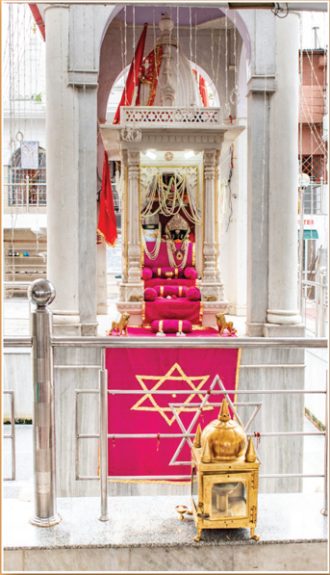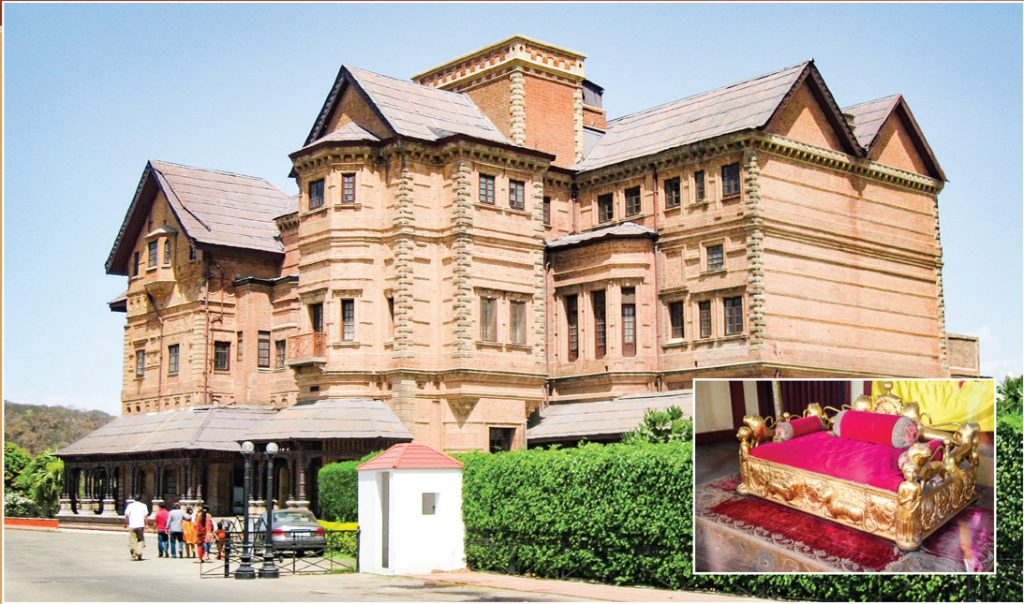Discover the Royal
Temples of Jammu
Since ancient times the royal families of Jammu have built and maintained temples and seen to the training of priests and scholars of Sanskrit to preserve a high level of worship. In our feature story we visit several of the city’s major temples, including Ragunath, until recently the largest temple in North India, and Ranbireshwar, the North’s largest Siva temple. The Dharmath Trust established by the kings is key to the temples’ continued well-being.
BY RAJIV MALIK, DELHI
NESTLED IN THE FOOTHILLS OF THE Himalayas beside the river Tawi is the temple city of Jammu. It is the winter capital of the state of Jammu and Kashmir, the heavily militarized northwest corner of India occupied in part by Pakistan and China. The district of Jammu is bordered by the Kashmir valley to the north, Ladakh to the east, Himachal Pradesh to the south and Pakistan-occupied Kashmir to the west.
The local people say Jammu, the city, was founded by King Jamboolochan in the 14th century bce. The story goes that he was hunting along the River Tawi and came upon a goat and lion drinking water together from the river. When they went their separate ways, he took this as a sign that he had entered a peaceful, divine place. He built a palace here, and the city of Jammu grew up around it.
Excavations at Akhnoor, less than 20 miles away, provide evidence the area was once part of the Harappan Civilization. The city is mentioned in the Mahabharata, and the Pandavas are said to have stayed here briefly. The area was militarily powerful during Muslim times and enjoyed considerable independence all the way to the modern era.
Many temples in Jammu city were built or expanded by the Dogra dynasty rulers in the 18th century. The Dogra rule came to an end in 1947 when Maharaj Hari Singh formally joined his kingdom to independent India.
In some other Indian states, such as Tamil Nadu and Andra Pradesh, the state government has taken over management of the Hindu temples within its borders (while not similarly interfering with the religious institutions of any other faith). In those states, the results have been problematic: temple funds have been diverted into state treasuries, temple assets unaccounted for and lands usurped. Jammu’s temples have escaped that fate. Most of these temples were in the hands of the Dharmarth Trust, created by in 1846 by Maharaja Gulab Singh and expanded by his successors. While the royal family controlled this trust, it was independent of the state government and remained so after Jammu and Kashmir’s incorporation into India in 1947.
Remarkably, the trust’s 120 temples—with the notable exceptions of Amarnath and Vaishno Devi Temple which were taken over—have continued to remain free from state control. The credit for this goes to Dr. Karan Singh, who today is the sole trustee. Dr. Singh is the son of the last Maharaja of Jammu and Kashmir and great-great grandson of Gulab Singh. He is an esteemed Hindu scholar, politician and diplomat who has served as a minister in India’s Central government, a member of the Rajya Sabha (India’s upper house of parliament), and ambassador to the United States.
In July of 2018, with the help of Dharmath Trust council president B. R. Kundal, HINDUISMTODAY was able to cover the trust’s major temples in and near Jammu, as well as a few independent temples.
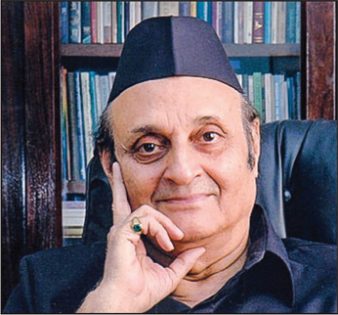
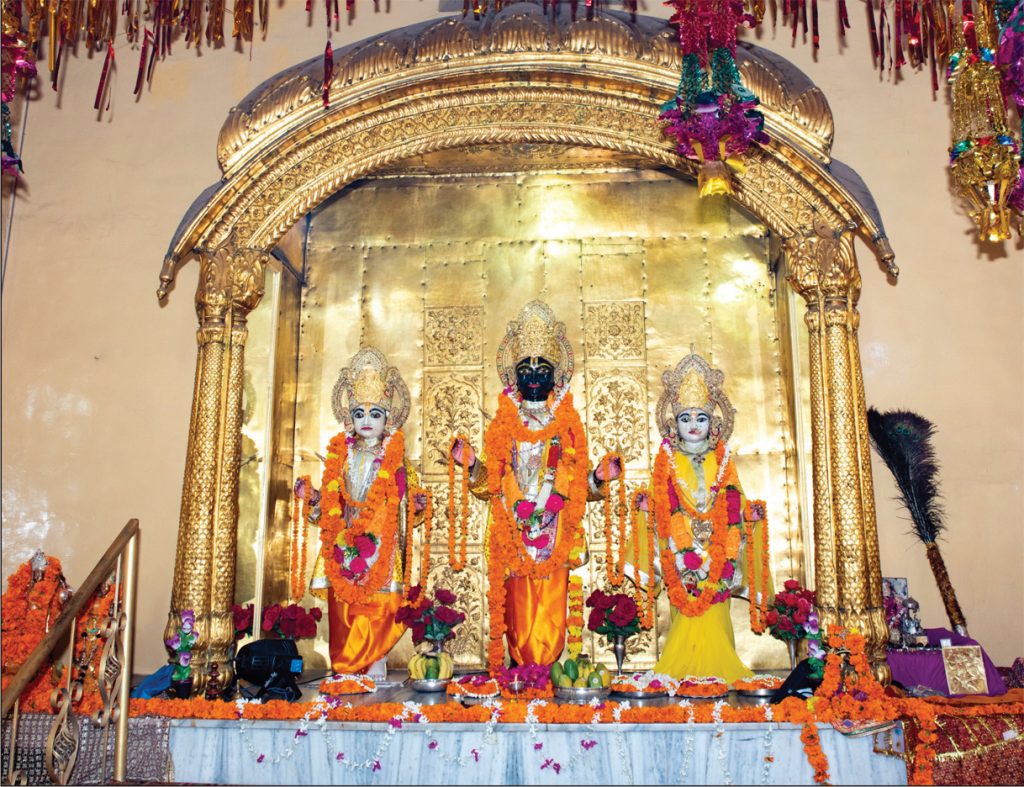
Lord Rama’s Jammu Home
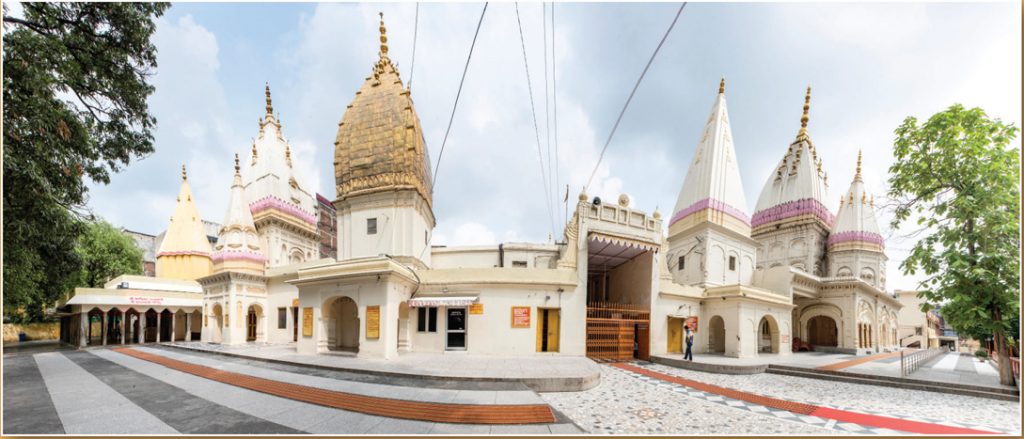
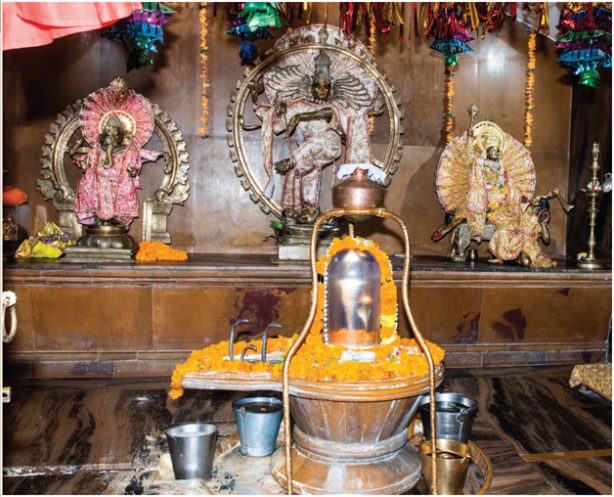
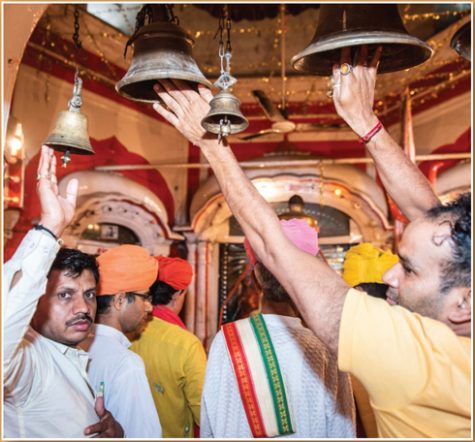
Shri Raghunath Temple
The star attraction of Jammu is the Shri Raghunath Temple, one of the largest and most opulent in the world. Many pilgrims only come here and visit no other temple. Until the recent creation of Akshardham Temple in Delhi, this was the largest temple in North India. It’s not a single temple, but a cluster of 25 to 30 temples and shrines on eight acres. All 330 million Gods and Goddesses are claimed to reside here in the hundreds of thousands of enshrined saligrams set in ahatas, or galleries. [YouTube: bit.ly/ragunath (in Hindi)]. Normal visitor traffic is one thousand a day; as many as ten thousand visit daily when the Amarnath Yatra is in full swing, as this is a required stop on the pilgrimage.
Raghunath Temple was built in 1857 by Maharaja Ranbir Singh. The central Deity is Lord Rama, eighth incarnation of Vishnu. Rama, patron Deity of the Dogra kings, belonged to the Raghuvansha dynasty of kings, hence the temple is named Raghunath.
Guiding us during one of our several visits here were Shri Kundal of the Dharmarth Trust and Pandit Darshan Kumar Sharma, the temple’s senior priest. Dr. Karan Singh had told us how dear to his heart this temple is, how he frequently participates in the major festivals, and about the various additions he has made to the temple, including the installation of Siva Nataraja, Goddess Bagulamukhi, Goddess Maha Kali and Lord Karttikeya. As well, he has installed a large, lead-crystal glass Sivalingam of remarkable clarity, made in Germany. He also provided the parade murtis of the main Deities for festivals.
The central murti of Lord Rama is of black marble—unusual in India—while the accompanying images of Sita and Lakshman are of white marble. The most attention-grabbing aspect of the central sanctum might be the ornate gold columns, gold panels on the altar, and sheets and sheets of gold on the walls and ceilings around the sanctum. More gold adorns the temple towers. It is one of the few places in North India where you can experience the opulent wealth bestowed upon the temples by the Hindu kings—the wealth that inspired centuries of invaders.
Raghunath Temple, built in British times, was never plundered. However, it was attacked twice in 2002 by fedayeen fighters of the Laskar-e-Toiba, a terrorist group based in Pakistan (and supported by its government), infamous for the 2008 attack on Mumbai that left 164 dead. The first attack on Raghunath Temple, made by two suicide bombers on March 30, 2002, killed 11 and injured 20. Temple security was massively fortified, but on November 24, 2002, two more terrorists attacked, killing 14 and injuring 45.
Today the Jammu-Kashmir police maintain a full-time post within the temple grounds. Devotees are thoroughly searched and must check their bags, phones and even pens before being allowed in. By benefit of being there at the personal invitation of Dr. Singh—whom many local people still refer to as “Maharaja”—we were allowed to bring in our cameras and freely take photos. The intense security has dampened the enthusiasm of local residents to come for worship, but visitors from outside continue to flock here despite the inconvenience.
The temple is a warren of shrines, halls and courtyards divided between an inner and an outer parikrama or circumambulation route. On the left as one enters are small shrines to Gayatri, Hanuman and Siva, then shrines to Dattatreya, Nataraja and Bagulamukhi. Also near the entrance are crypts holding the ashes of the kings Ranbir Singh, Gulab Singh and Raja Amar Singh.
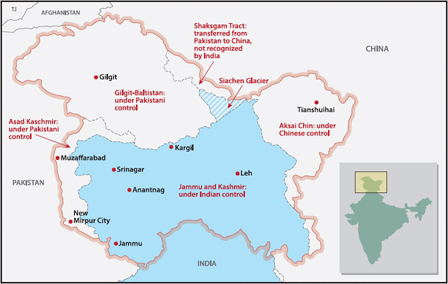
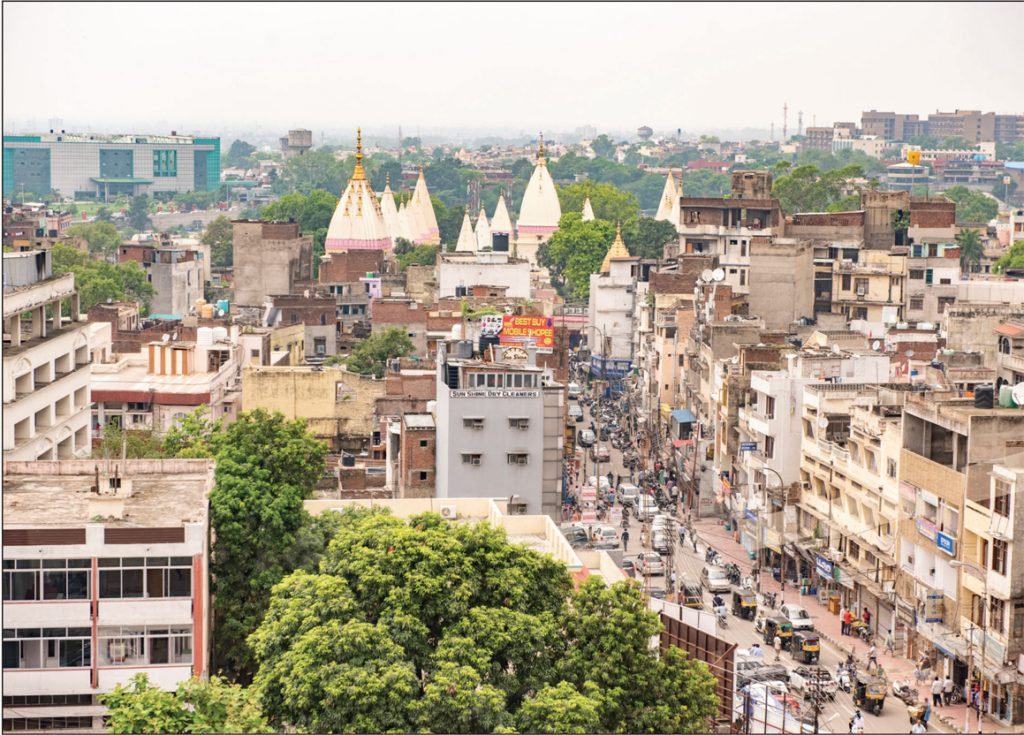
Ragunath Temple Environs

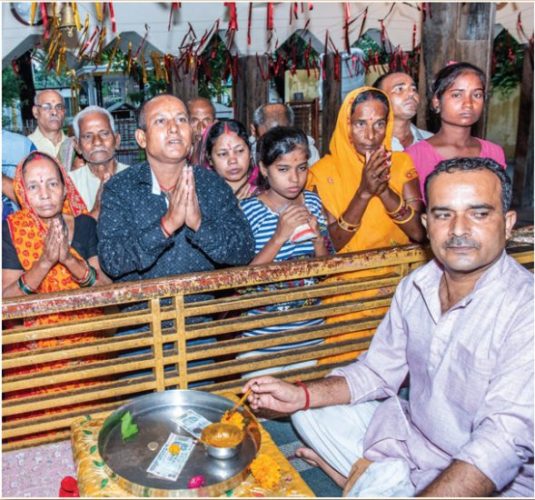

There are a total of 20 shikharas, ornate towers, in the complex, with the largest being over the main Ragunath shrine. There are shrines dedicated to Krishna, Vishnu and His incarnations, Mata Vaishno Devi, another Hanuman and various sages and rishis including Shankaracharya, Dharmaraja, Narada and Yamadoota. Dr. Karan Singh and his wife added the temples to Vaishno Devi, Siva Nataraj, Mahakali, Karttikeya and several saints.
Eight halls in the inner route house the temple’s 125,000 saligrams. A saligram, a fossilized shell from the Gandaki River in Nepal, represents Vishnu as the Universal Principle. Like the Sivalingam, this aniconic image is intended to convey the abstract aspect of God.
Visitors often spend many hours exploring the large temple. Their highlight is attending one of the major aratis, or worship services, done by the priests of all two-dozen-plus main shrines. Attired in colorful Dogra dress, they move rapidly as a group from shrine to shrine, worshiping all the Gods, Goddesses, and saligrams with Vedic mantras, gongs, cymbals, conch and drums.
At the rear of the Raghunath complex is the Ranbir Sanskrit Research Centre and Library, which houses rare manuscripts in Sanskrit and other languages. The librarian, Dr. Renu Gupta, explains that research scholars and academics utilize the facility. A staff of four is systematically digitizing the collection.
During the reign of Ranbir Singh, the temple was a center of Sanskrit teaching. Later the school was moved to Beerpur on the outskirts of Jammu. The temple also housed a translation center where books on philosophy and history in Arabic and Persian languages were translated by Muslim scholars into Sanskrit. Similarly, Hindu pandits have translated many scriptures into Hindi and Dogri languages. This initiative has contributed to communal harmony among the Hindu, Muslim and Christian Dogra.
After visiting the temple, nearly everyone stops at the Raghunath Bazaar outside the temple. The Bazaar’s 200 shops do a roaring business in dry fruits—the expected gift for relatives and friends when returning home from Jammu. Also available here are woolens and the normal products of any general market. Many of the shops are owned by the Dharmarth Trust, and their rents are a significant source of income.
Shri Ranbireshwar Temple
Said to be the biggest Siva temple in North India, Shri Ranbireshwar is very popular with pilgrims and Jammu residents alike. Located on a hillock about half a mile from Raghunath, it was begun in 1863 and completed in 1878 by Maharaja Ranbir Singh. [bit.ly/ranbireshwar (in Hindi)]. It, too, is owned by the Dharmarath Trust, whose headquarters is nearby. It is also close to the Jammu and Kashmir state government offices.
The security here is relatively light compared to Raghunath Temple. One walks up a large number of stairs to reach the temple. In front of the complex is a huge statue of Maharaja Ranbir Singh atop a tall multi-pillar base. To the left and right of the temple’s central sanctum are large halls with shrines to Ganesha and Karttikeya. An exquisite one-ton brass Nandi in a glass enclosure faces the central sanctum, where one encounters an eight-foot-tall black Sivalingam [see this issue’s cover] along with murtis of Siva and Parvati. Immediately in front of the Siva/Parvati is a 15-inch natural crystal Sivalingam surrounded by 11 smaller crystal Lingams. As with Raghunath, gold is everywhere in abundance. Visiting several galleries in the complex, one can see 125,000 Sivalingams, brought here from the Narmada River and worshiped daily. Nearby is the samadhi shrine of Mahant Shri Naad Giri, the saint who inspired the king to build this temple.
Attending the morning Rudrabhishekam is quite an experience. The devotees are allowed to touch the Sivalingams and make offerings over them while the priests are chanting Vedic mantras. Our visit is during the Hindu month of Shravan, when this worship is performed every morning for forty days, attracting a large number of devotees, including many from Jammu itself.
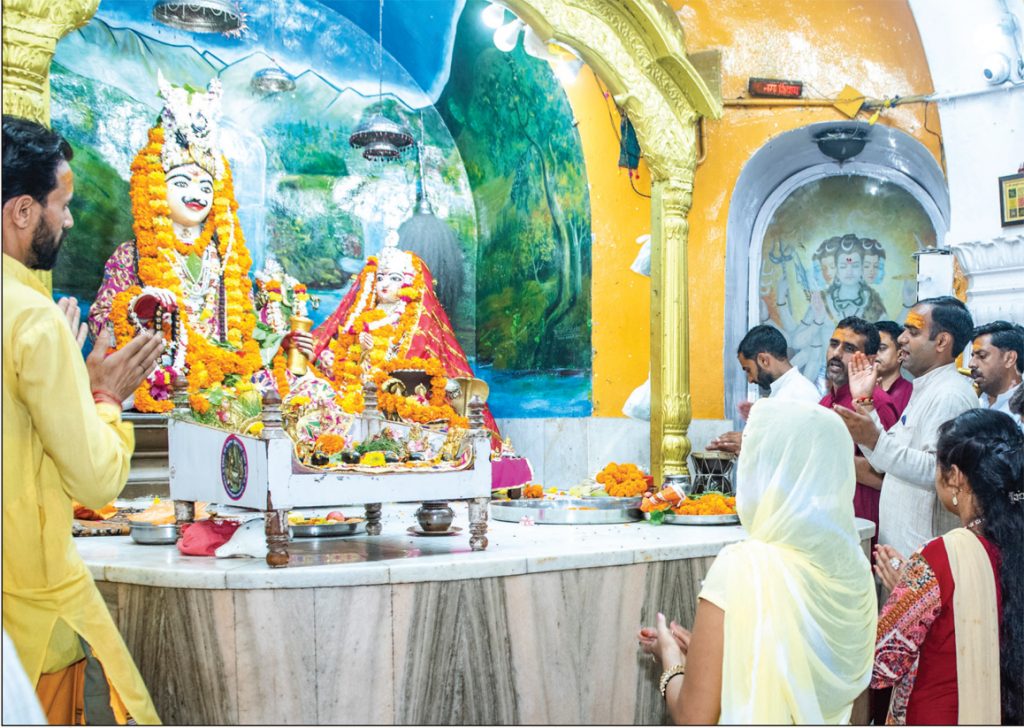
Shri Ranbireshwar Siva Temple
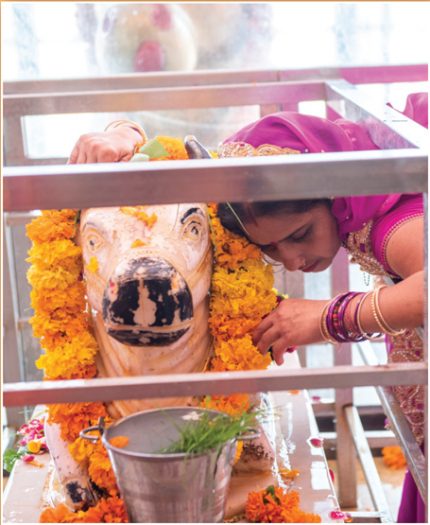
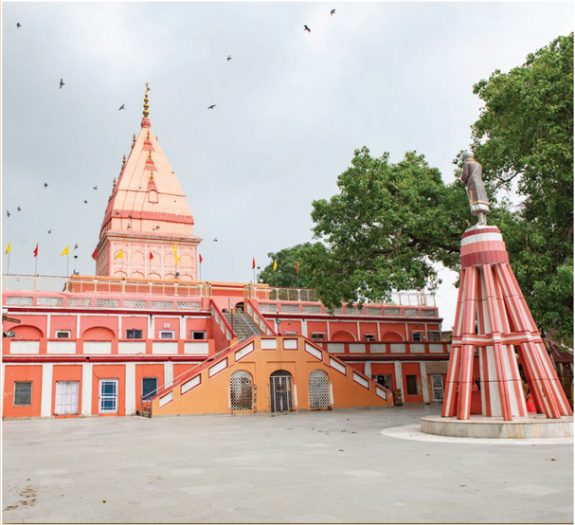
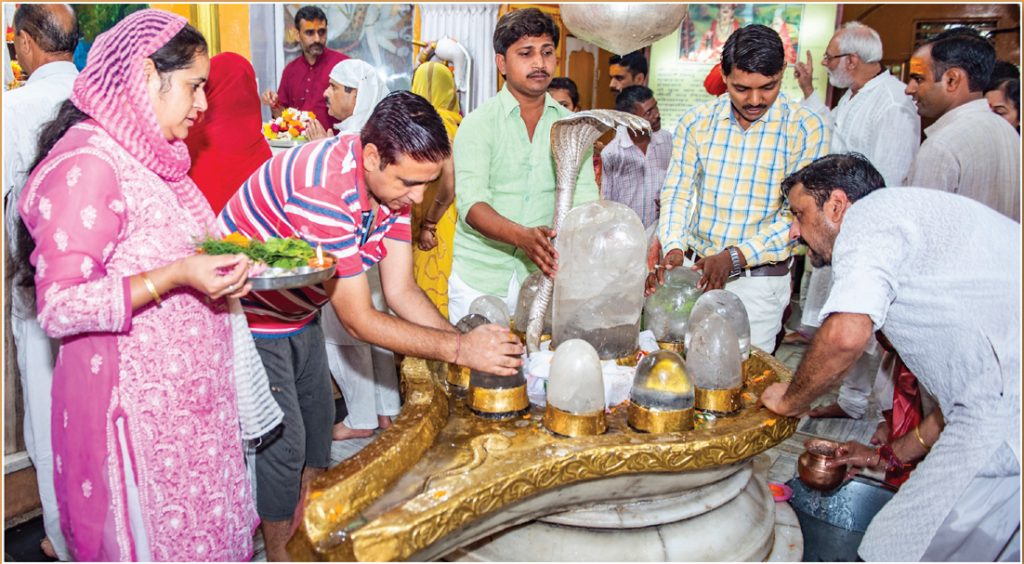
Purmandal Temple
This ancient temple, built by Raja Avantivarman, who ruled Kashmir from 855 to 883, lies on the banks of the Devika River about 35km southeast of Jummu city. The area is known today as Little Kashi. It serves the same purpose as the sacred city of Kashi (Banaras) on the Ganga. The ashes of those who have passed on are immersed in the Devika River and the various rituals for one’s ancestors are performed.
In addition to Purmandal and other temples, there are a large number of old sarais (rest houses, the roadside inns of their day), dharamshalas (pilgrim accommodation) and havelis (mansions) built by the kings preceding the Dogras. Some of these remain in good condition. A cremation ground is nearby. At one point in time, this was a great center for devotion, religion and Sanskrit learning. A YouTube video by Dharmarth Trust, who manage Purmandal, has some stunning aerial footage of the temple and river [bit.ly/puramandal].
During our visit, the river is flowing strongly; even so, the locals waded across to reach the temple. The riverbed is dry during the summer; but for immersion of ashes, people need only dig down a foot or so to reach water. We city dwellers opted to drive to a nearby bridge to cross the river and then walk to the temple.
The chief priest, Anil Goswami, performed puja for us and told us about the complex. It is a Siva temple, but has no Sivalingam as such. There is a base for a Sivalingam, but the Lingam itself is said to have been absorbed into the altar, leaving a hole into which devotees pour water. Goddess Parvati here is represented by a pindi, a natural rock formation something like a Lingam, but shorter and rounded. Water offered to the Lingam base simply disappears. Maharaja Ranjit Singh took an interest in this mystery but was unable to solve it even after having his army men offer water continuously. A flame kept lit on the altar continuously is also a focus of worship. There are a dozens of smaller temples within this complex, including 121 small Siva temples enshrining a total of 1,337 natural Sivalingams.
Purmandal was visited by the 15th-century founder of Sikhism, Guru Nanak, who interacted with the kings and historical figures of the area. Nanak was born in Lahore, 110 miles southwest of Jammu. Later Sikh gurus also traveled through Jammu and Kashmir, and there has been a small population of Sikhs in both parts of the state ever since.
We met a group of pilgrims who had come from Gurdaspur in Punjab to perform rites for their ancestors. They told us many people from Punjab and other states of North India pilgrimage here.
Bawey Wali Mata Temple
The most important Shakti temple in Jammu region honors Goddess Bawey Wali Mata. Overlooking the Tawi River, it was built within the Bahu Fort by Maharaja Gulab Singh shortly after his coronation in 1822, as part of a general restoration of the ancient fortress. Bawey Wali Mata, or Mahakali, is the reigning Deity of Jammu, and the kuladevi, family Goddess, of the Dogra rulers. The fort is said to have been built 3,000 years ago by Raja Bahulochan. It was rebuilt in 1585 by Autar Dev and renovated multiple times since—a testament to its once strategic location opposite old Jammu city. It is still well maintained with adjacent gardens and is a major area attraction.
This is a small temple, built in white marble on a raised platform of about four feet. It can accommodate only a few worshipers at a time. When we visited on a Tuesday evening, hundreds of devotees are waiting in long lines to have darshan of the Goddess. Order is maintained by police and temple volunteers.
The murti of the Goddess, made of black stone, has a powerful spiritual vibration. The priests accept offerings and return prasadam at lightning speed. The common offerings are sweets, pudding, puffed rice, flowers and cash. Earlier, animal sacrifice took place here, but the practice was prohibited by Maharaja Pratap Singh (reign: 1885–1925) upon the recommendation of a local saint.
Nearby halls house other small temples where people are worshiping and singing bhajans. Elsewhere on the temple’s huge campus, people wait for the free meal being distributed.
It is a custom here to tie a red dupatta, a women’s scarf-like shawl, on the railings along each side of the path to the main temple in thanks for wishes fulfilled by the Goddess. The colorful sight is testimony to the devotion of those who come, and to the efficacy of their prayers.
The twice-yearly Navaratri festivals, called Bahu Melas, are major events here. Another feature of the temple is the largest band of Rhesus monkeys in Jammu and Kashmir state. These are offered sweets—and are not above snatching what they want if it is not readily handed over voluntarily.
Panjvaktra Mahadev Temple
Located in the heart of Jammu City just a kilometer from Raghunath, this popular and ancient Siva temple was rebuilt in the 17th century by Raja Guje Singh (1687–1703). The central murti is a swayambhu, self-manifested Sivalingam, with five faces representing Siva’s five aspects: Sadjyojata, Aghora, Vamadeva, Tatpurusha and Ishana. Devotees can personally perform abhishekam to this Lingam. In one area, silver coins are embedded in the stone floor slabs; one name for the temple is “Rupee Temple.”
This temple was visited by Guru Nanak sometime around 1514. He is said to have been consulted by the local king, Raja Khokhar Dev, for guidance on how to rule according to dharma. The two are said to have spoken under an jujube tree, which remains to this day. It is always blooming and is highly revered by devotees.
Peer Kho Temple
One of the more unusual temples in Jammu is Peer Kho, the Saint’s Cave, so named in honor of Yogi Guru Garib Nath, a sadhu of the Natha Sampradaya who once lived here. The cave lies east of Jammu in a dense forest near the Tawi River, a few kilometers from Raghunath. It was built in its present form by Raja Biram Deva (1454–1495) and continues to be managed by Natha sadhus, who maintain a dhuna, or sacred fire, here around the clock. Thousands of devotees come each year to celebrate Mahasivaratri.
This temple is also called Jambavan Gufa, or Bear Cave, so named after the Bear God Jambava, who figures in the Ramayana as well as in the life of Krishna. He was an ardent devotee of Lord Siva and is regarded as one of the seven immortal living beings—Hanuman being another—mentioned in the Puranas, Ramayana and Mahabharata.
We spoke with the priest, Ashok Kumar Sharma, who was seated beside the naturally formed black Sivalingam in the small five-sided cave. Only a few devotees can enter at a time—but at twelve feet high, it is reasonably comfortable. An adjacent cave less than six feet high leads to an area with shrines to many Gods and Goddesses. We spoke with one of the Natha yogis here and had darshan of the main mahant, who was in a contemplative mood and blessed us without speaking. We also encountered a group of pilgrims from Uttar Pradesh who had just returned from Vaishno Devi and were headed home.

The City’s More Ancient Temples

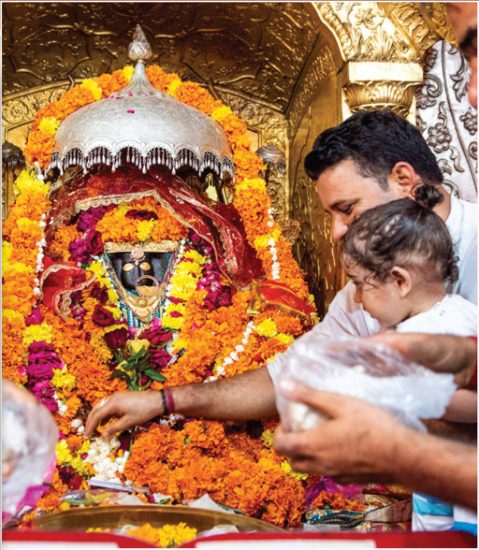


Kameshwar Temple, Akhnoor
We were directed to this temple by a prominent saint of Jammu, Mahant Rameshwar Das of Shri Ramji temple. Akhnoor town, 40km from Jammu, is believed to be the ancient city of Virat Nagar mentioned in the Mahabharata. Archeological excavations have revealed the site to be one of the last bastions of the Harappan Civilization.
The temple is dedicated to Lord Siva in the form of a self-manifested pindi. The priest, Sadhu Brij Mohan Das told us Kameshwar is a wish-fulfilling temple, especially popular with couples seeking children.
Nearby is the Jio Pota Ghat, on the banks of the Chenab River. Here, on June 17, 1822, Gulab Singh was proclaimed king through the raj tilak, or coronation ceremony. This was the beginning of the Dogra dynasty and ultimately the modern state of Jammu and Kashmir. A commemorative tablet depicts that scene.
Kol Kandoli Temple, Nagrota
In the old days, when pilgrims reached Vaishno Devi on foot, their first glimpse of the mountainside temple was from Kol Kandoli, where they would make a night halt. Today many pilgrims visit here on their way to Vaishno Devi or on their return. Home to an Indian army base, the town is a high security area just a few miles from the Pakistan border. Seven solders were killed here in a 2016 attack by militants, and one must pass through a military checkpoint to reach the temple.
As in many temples in Jammu, the Goddess is worshiped here in the form of a naturally occurring pindi rock. It is said Mata Vaishno Devi Herself graced this place as a five-year-old girl and performed penance for twelve years. In another story, the Pandavas encamped here during their exile and were blessed by a vision of the Goddess, who directed them to build this temple. One shrine in the Kol Kandoli complex is maintained by the army; the priest is a soldier, though most visitors would be unaware of this.
One can judge the temple’s popularity not only by the fact the temple is overflowing with devotees, but by the large adjacent market doing a thriving business in all the required items for worship at the temple. The vibhuti, sacred ash, sold here is made from the flowers offered to the Goddess and famed for curing skin problems.
The Kashmir Pandit Temple
Over half-a-million Hindus fled Kashmir in 1989-90 following attacks by Muslim insurgents, with tens of thousands landing in refugee camps in Jammu. Life was severely difficult for them in the early years, but as they became better settled, they built the Mata Kheer Bhawani Temple in the residential colony of Janipur. A huge multistory well-maintained building on a hillock, it is intended as a replica of the famed Kheer Bhawani Temple in Tullamulla, Kashmir, which was rebuilt by Dogra King Pratap Singh in 1920 and is managed by the Dharmartha Trust. This Jammu temple, however, belongs to a trust founded by the Pandits.
Trust president R. L. Dhar told us Kashmiri Pandits come from all over India and even abroad to worship here if they cannot go to the original in Kashmir. The temple is also popular with the local Hindus. It has two full-time priests, a huge kitchen that serves hundreds of devotees at a time and a well-stocked shop where devotees can buy offerings and puja supplies. It serves as a kind of central clearing house for Pandit families seeking suitable matrimonial alliances for their children.
Educational and Cultural Institutions
In addition to its temples, the Dharmarth Trust owns schools, museums and libraries in Jammu, all founded by the Dogra dynasty. We first visit Shri Raghunath Sanskrit Mahavidyalaya, a large complex with two temples on the outskirts of Jammu. A group of about 70 students welcome us with Vedic chants. School principal Praveen Khajuria tells us the school was first established in 1858 by Ranbir Singh on the premises of the Raghunath Temple. Until 1938 it functioned as a government institute, and then was transferred to the Dharmarth Trust. The school became widely known for the brilliant Sanskrit priests, scholars and teachers it produced. The school’s present large facility was built in 1896 by Pratap Singh, and taken over for the school in 1986. Praveen says the school now provides a blend of modern and Sanskrit education to its students. With the support of the Trust, and Dr. Karan Singh personally, education, room and board remain free of charge for all students.
The Amar Mahal Museum and Library, originally the Amar Mahal Palace, is an internationally known institution with a collection of some 31,000 rare books, art works, photographs and artifacts connected to the Dogra dynasty. The palace, designed by a French architect along the lines of a French chateau, was built in the 1860s by Raja Amar Singh on a bluff overlooking the River Tawi, with a clear view of Vaishno Devi Temple on the mountains far to the north. It is adjacent to the Hari Niwas palace, now a hotel, the last official residence of the Dogra rulers. The entire area is beautifully landscaped with vast lawns. The museum and library are run by the Hari Tara Charitable Trust, created by Hari and Tara Devi in 1970 for educational, cultural, literary and philanthropic activities. The building was donated to the trust by their son, Dr. Karan Singh.
The manager, R. S. Pathania, gave us a tour of the historic building. There is the Darbar Hall, filled with imposing portraits of the Dogra rulers and featuring the 230-pound gold throne of the Maharaja. Along the walls are a large set of paintings in Kangra Miniature style. One can even visit the private quarters of Maharani Tara Devi, which has been preserved as it was in her lifetime with various personal memorabilia and garments.
The palace’s dining room has been converted into a Nepal room in memory of Dr. Karan Singh’s late wife, Yasho Rajya Lakshmi, a Nepali princess, who took an active interest in developing the museum. Another area displays photographs from Dr. Karan Singh’s life and political involvement, from being the state’s last prince to associating with Nehru, the Indira Gandhi family and various world leaders including Soviet premier Nikita Khrushchev, serving as India’s ambassador to the United States and lastly as a member of India’s upper house, the Rajya Sabha, from which he recently retired.
The Dogra Art Museum is in the old Mubarak Mandi palace, a former royal residence of the Dogra kings, a mile from Amar Mahal. The palace, dating back to 1824, incorporates elements of Rajasthani and Mughal architecture. The museum, begun in 1954, is located in the palace’s Pink Hall. It was expanded in 1991 and presently houses more than 7,000 historical objects. These include paintings from the Basholi, Kangra and Jammu schools of art, a stunning collection of 18th-century Krishna and Sudama paintings, and a large set of beautiful handwritten Persian manuscripts. In addition to the artworks are collections of Dogra arms and armory, jewelry, metalware, musical instruments and historical documents.
Conclusion
During our six days in Jammu, we learned much about the Dogra community and its rulers. We came to appreciate their valor, love for Sanatana Dharma, and role as prolific temple builders. I was impressed that Dr. Karan Singh, while holding multiple public offices, was at the same time serving the temples of Jammu as head of the Dharmarth Trust. A few other scions of India’s royal families have been of similar value to their former kingdoms. Others, however, have become businessmen or even opted for a life of ease, living off the family’s fortune. In Jammu, we see the proper fulfillment of the royal kshatriya dharma in the protection and promotion of Hindu religion and culture.
The City’s More Ancient Temples
